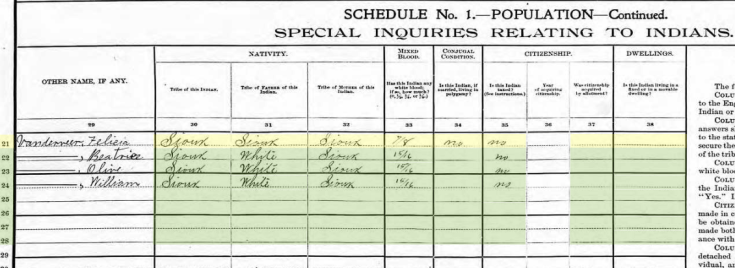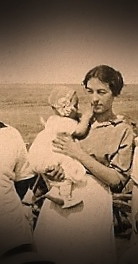By Eilene Lyon
Race in the Census
From the very first U. S. Census in 1790, the enumeration was focused primarily on whites, and secondarily on everyone else. A person was listed as Free White, Other Free Person, or Slave. Based on the constitution, non-taxed Indians were specifically excluded.1
It wasn’t until the 1850 Census, when every household member was listed by name, that each person was assigned a “color.”2 The 1870 Census was the first to enumerate all people as individuals, including former slaves. For the first time “Chinese” (any east Asian) and “Indian” races were added to the Color column.3
In the last two federal censuses, the U. S. Census Bureau was required to adhere to the 1997 Office of Management and Budget standards on race and ethnicity (here).
This article describes two cases of “non-white” people in the census. One is from my family tree, the other is from another research project I undertook regarding my current hometown. That case is unresolved.
Finally, I present my case for a color-blind census, at least for the constitutional purpose of drawing congressional districts.
Ray Springer and Beatrice Vandeveer
My 1st cousin 3x removed, Ray Springer, was born in South Dakota on September 14, 1892.4 His paternal grandparents were both German immigrants.5 His maternal grandparents were born in Maine and Illinois.6 White as white can be, eh?
On August 11, 1915, Ray Springer married Beatrice Vandeveer in Codington County, South Dakota.7 As her name would suggest, Beatrice’s father was of Dutch descent. Her mother was Felicia, the daughter of a French Canadian and a white woman born in Iowa. Based on information from the 1900 Census,8 I was able to determine the following:
Beatrice’s father, George Vandeveer, was listed as white, and living on the Cheyenne River Indian Reservation in Dewey County, South Dakota. Felicia was listed as having both parents in the Sioux tribe, but her percentage of “white blood” was given as 7/8. In other words, one of her parents was ¾ white, and the other was 100% white. So, Felicia is listed as Indian, though she has a single great-grandparent of Native American blood.
Because Felicia is listed as Indian, all of her children are, too. Beatrice and her siblings are listed as having 15/16 white blood. They had just one native ancestor, a great-great-grandmother.

Back to Ray Springer and Beatrice. In 1920, the Springer family, including three children, were living in Dewey County. Beatrice and all of the children are listed as Indian. The children were, at most, 1/32 Indian “blood.” They had a single great-great-great-grandmother who was Native American.9
As long as Beatrice and Ray’s children lived at home, the census-takers recorded them as Indian. Once they left home, the census-takers recorded them as white.

Beatrice Vandeveer Springer (Ancestry.com – debbiedjm originally shared this on 03 Aug 2012)
Albert Wooten
I live in southwestern Colorado, which has a rich Native American and Hispanic heritage. My community, aside from those two groups, is very white. There are few blacks or Asians. There were only 34 blacks in Durango in 1890, many of them working as porters for the Strater Hotel.10 My curiosity led me to search the 1885 Colorado Census for these under-represented groups.
One black family I found was Albert Wooten’s. He was born in Alabama in 1830 and was living with six of his children, including two sets of twins, all born in Mississippi. All were listed as Black.11 There was no mother in the household.
The record didn’t seem odd until I contacted someone who appears to be Albert’s descendant. She informed me that her belief is that Albert was a white man, and she has some evidence (including DNA matches to white Wootens) to that effect. Certainly a government that considers a child to be Indian if they are 1/32 Indian would consider a man living with six black children to be black.
In an episode of “Finding Your Roots” with Henry Louis Gates, Jr., he searches for his white ancestor and discovers that once his ancestor freed his slave and took her as his wife, the census began enumerating him as black. So, there is an example of a white man being listed as black.
I’ve found very few records for Albert, but in the 1900 Census, when he is living alone, he’s listed as black, making it seem likely that he was, indeed, black.12
The Case for a Color-Blind Census
There’s no doubt that census records are a boon to genealogists. They provide a home location for our ancestors every ten years, and include information such as occupation, place of birth, arrival in the U. S. (for immigrants), finances, and much more. It’s a rich trove and invaluable to researchers.
The constitutional purpose for the census, however, is to enumerate the population for the purpose of allocating representation in congress by creating voting districts. The demographic information has many valid social uses for government-funded programs. Fortunately, census-takers no longer assign you a color based on blood percentages. Now, all race/ethnicity information is self-reported. But what use is this information to the creation of voting districts?
One word: Gerrymandering.
Political committees re-drawing congressional districts need only two pieces of information: “How many people are there?” and “Where do they live?”
Census information should be stripped of every other demographic detail when used for drawing districts: sex, age, race, occupation, etc. should never be considered in a one-person-one-vote country. Removing these details would defeat gerrymandering and ensure districts are based strictly on population and nothing more.
Then there is the fact that race is an artificial and arbitrary concept, unnecessarily divisive, and thus should be left off the census entirely, but I’ll spare you that until another time.
Feature image: Photo by rawpixel on Unsplash
- https://search.ancestry.com/search/db.aspx?dbid=5058 ↩
- https://support.ancestry.com/s/article/1850-U-S-Census?ui-self-service-components-controller.ArticleTopicList.getTopics=1&r=2&ui-communities-components-aura-components-forceCommunity-breadcrumbs.Breadcrumbs.getAncestors=1&ui-comm-runtime-components-aura-components-siteforce-qb.Quarterback.validateRoute=1&other.AncestrySFSC_ContactUs.getContactUsConfs=1&ui-force-components-controllers-recordGlobalValueProvider.RecordGvp.getRecord=1&ui-self-service-components-controller.ArticleView.getArticleHeaderDetail=1 ↩
- https://en.wikipedia.org/wiki/Race_and_ethnicity_in_the_United_States_Census#1870_Census ↩
- Springer, Ray Edward. Ancestry.com. South Dakota, Birth Index, 1856-1917 [database on-line]. Provo, UT, USA: Ancestry.com Operations Inc, 2003. ↩
- Springer, Richard. Year: 1880; Census Place: Clinton, Vernon, Wisconsin; Roll: 1448; Page: 227B; Enumeration District: 004. 1880 United States Federal Census [database on-line]. Lehi, UT, USA: Ancestry.com Operations Inc, 2010. ↩
- Sumner, Levi. Year: 1880; Census Place: Albion, Howard, Iowa; Roll: 344; Page: 425C; Enumeration District: 240. 1880 United States Federal Census [database on-line]. Lehi, UT, USA: Ancestry.com Operations Inc, 2010. ↩
- Springer, Ray and Beatrice Vandeveer. Ancestry.com. South Dakota, Marriages, 1905-2016 [database on-line]. Lehi, UT, USA: Ancestry.com Operations Inc, 2005. ↩
- Vandeveer, George. Year: 1900; Census Place: Cheyenne River Indian Reservation, Dewey, South Dakota; Page: 25; Enumeration District: 0048. 1900 United States Federal Census [database on-line]. Provo, UT, USA: Ancestry.com Operations Inc, 2004. ↩
- Springer, Ray E. Year: 1920; Census Place: Township 17, Dewey, South Dakota; Roll: T625_1719; Page: 2A; Enumeration District: 47. 1920 United States Federal Census [database on-line]. Provo, UT, USA: Ancestry.com Operations, Inc., 2010. ↩
- Smith, Duane A. 1992. Rocky Mountain Boom Town: A History of Durango, Colorado. University Press of Colorado, Niwot, Colorado. ↩
- “Colorado State Census, 1885,” database with images, FamilySearch (https://familysearch.org/ark:/61903/1:1:K8WN-G1C : 1 April 2016), Albert Wooten, 1885; citing NARA microfilm publication M158 (Washington, D.C.: National Archives and Records Administration, n.d.); FHL microfilm 498,507. ↩
- Wooten, Albert. Year: 1900; Census Place: Bland, Bernalillo, New Mexico; Page: 3; Enumeration District: 0021. Ancestry.com. 1900 United States Federal Census [database on-line]. Provo, UT, USA: Ancestry.com Operations Inc, 2004. ↩
Really really interesting.
LikeLiked by 1 person
Thanks!
LikeLiked by 1 person
One would think that gerrymandering politicians would keep a sharper eye on voting patterns than demographics. While voting trends tend to chase demographics, it is more precise to measure and account for the former than the later.
LikeLiked by 1 person
Voters are really fickle in many areas. They vote for Obama, then Trump, etc. At least a third of Colorado voters aren’t registered to a party.
LikeLiked by 1 person
In 2016, Hillary Clinton’s campaign manager, Robby Mook, illustrated the folly of relying on demographics for political decision making. Even though he precisely understood the race, sex, ethnicity and occupation of voters by census tract – those things did not tell him what they were thinking.
That election voters who had voted for Obama switched to Trump – but why?
The answer is simple. Both Barack Obama and Donald Trump campaigned as disruptive candidates. They both offered change. It is what the swing voters wanted and reflects a profound dissatisfaction with the status quo.
Unfortunately, Robby worked for a candidate who was viewed as status quo.
If Robby Mook had been watching voting patterns in the minor and off year elections, he would have noticed a sea change in the rural and blue collar vote.
Another note on demographics.
In my career, law enforcement (retired, not a cop), I tracked the age, race, gender and ethnicity of victims and offenders for state and federal reporting purposes. While demography speaks loudly about who commits crimes – it is all but useless to say whether the person in front of me might be a suspect – but their past behavior does. So look at it this way,if there are two persons of interest, one a 24 year old black male with no criminal history and the other a 40 year old white woman with an extensive criminal history. which would you bet on? Either way, one must follow the facts but if you are a betting person, you bet on history.
LikeLiked by 1 person
Mook is probably right, but I’m not certain voting patterns matter. I still believe, either way, that districts should be based strictly on population and that they should look more like squares drawn along regular boundaries and less like Tinker-toy creations designed by Machiavellian schemers.
LikeLike
Your genealogical research has helped you understand your past and that is good. But I also see it as confirmation that certain groups of people have always [and will always?] feel the need to be better than other groups of people– hence the minute percentages of race within one person. My mind doesn’t even begin to go in the direction of those census takers. Talk about uptight and divisive information. Don’t want, don’t need it.
LikeLiked by 1 person
The census takers were just community members hired for the temp job and the government was very specific in their instructions. The locals did not have discretion to make those race percentages up. In the case of Felicia Vanderveer (7/8 white) she was listed as a “Ration Indian” meaning she was using tribal membership to acquire government benefits in 1900.
LikeLike
Interesting. Huh.
LikeLiked by 1 person
These days people love to get their DNA tests to see their “percentages” but it seems ridiculous to me for the government to be making racial and ethnic distinctions.
LikeLiked by 1 person
I agree.
LikeLiked by 1 person
The quality of Census entries greatly depended on the Census taker. In my 30 plus years of genealogy research, I have seen so many mistakes including mis-assigned sex, race and name entries. In my opinion, Census records are one of the least reliable genealogy resources. They have their place but must be verified through other sources, when available.
LikeLiked by 1 person
Absolutely true! Not only did the census takers make errors, the people who transcribe the documents make errors. Always look at the image of the original sheet. Sometimes, it can be hard to find other evidence.
LikeLike
The only reason I can think of to ask about race or ethnic is to help police identify suspects. Well, one more. Medical reasons. Sometimes in choosing medical treatment or diagnosiing illnesses it is useful to have some genetic information about the patient. Other than that I fin’t see any reason for that information.
LikeLike